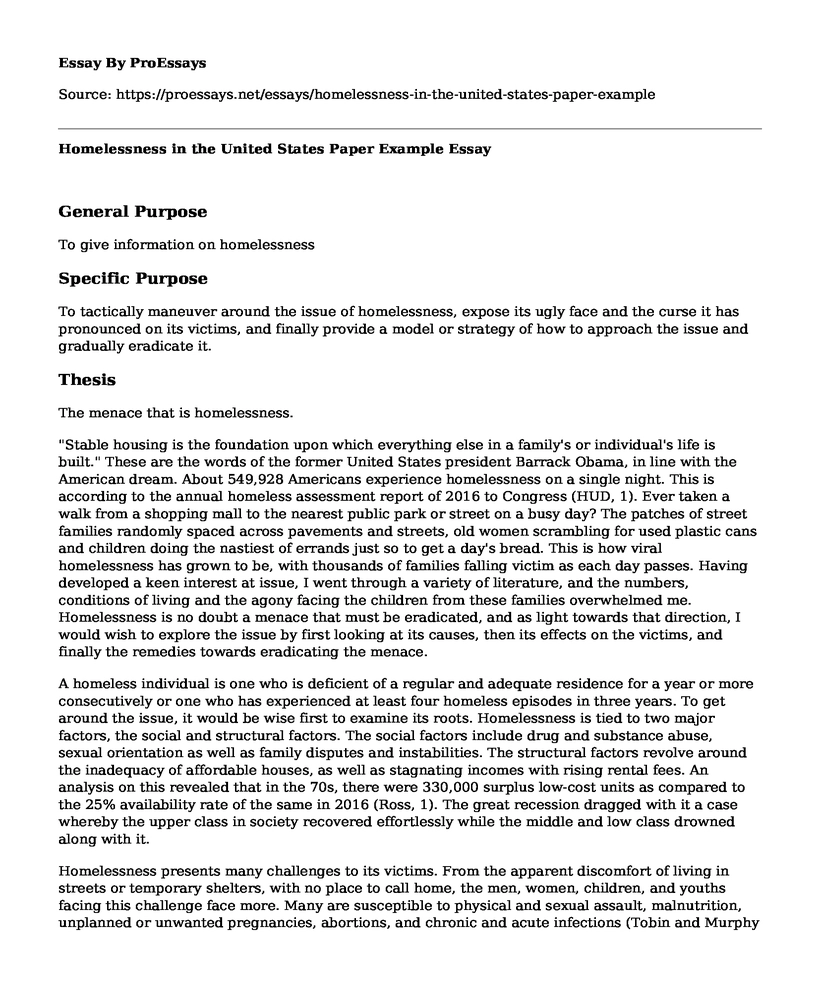General Purpose
To give information on homelessness
Specific Purpose
To tactically maneuver around the issue of homelessness, expose its ugly face and the curse it has pronounced on its victims, and finally provide a model or strategy of how to approach the issue and gradually eradicate it.
Thesis
The menace that is homelessness.
"Stable housing is the foundation upon which everything else in a family's or individual's life is built." These are the words of the former United States president Barrack Obama, in line with the American dream. About 549,928 Americans experience homelessness on a single night. This is according to the annual homeless assessment report of 2016 to Congress (HUD, 1). Ever taken a walk from a shopping mall to the nearest public park or street on a busy day? The patches of street families randomly spaced across pavements and streets, old women scrambling for used plastic cans and children doing the nastiest of errands just so to get a day's bread. This is how viral homelessness has grown to be, with thousands of families falling victim as each day passes. Having developed a keen interest at issue, I went through a variety of literature, and the numbers, conditions of living and the agony facing the children from these families overwhelmed me. Homelessness is no doubt a menace that must be eradicated, and as light towards that direction, I would wish to explore the issue by first looking at its causes, then its effects on the victims, and finally the remedies towards eradicating the menace.
A homeless individual is one who is deficient of a regular and adequate residence for a year or more consecutively or one who has experienced at least four homeless episodes in three years. To get around the issue, it would be wise first to examine its roots. Homelessness is tied to two major factors, the social and structural factors. The social factors include drug and substance abuse, sexual orientation as well as family disputes and instabilities. The structural factors revolve around the inadequacy of affordable houses, as well as stagnating incomes with rising rental fees. An analysis on this revealed that in the 70s, there were 330,000 surplus low-cost units as compared to the 25% availability rate of the same in 2016 (Ross, 1). The great recession dragged with it a case whereby the upper class in society recovered effortlessly while the middle and low class drowned along with it.
Homelessness presents many challenges to its victims. From the apparent discomfort of living in streets or temporary shelters, with no place to call home, the men, women, children, and youths facing this challenge face more. Many are susceptible to physical and sexual assault, malnutrition, unplanned or unwanted pregnancies, abortions, and chronic and acute infections (Tobin and Murphy 3)). The stress of being away from the people that matter, the financial constraints, and drug abuse act as vectors to psychological dysfunctionality. To the school going children, their unfavorable living conditions often act as hindrances to their cognitive as well as physiological growth. Having put the cause to the phenomenon and explored its impact on individuals, it is only to look for ways out.
To effectively counter homelessness, two main strategies have been put across. These are the Continuum of Care (CoC), and the permanent supportive housing (PHS). The former is contingent on the behavioral as well as mental changes of an individual before accommodation while the latter, specifically through the housing first initiative offers accommodation as the most urgent intervention. Other interventions that might seek to eradicate the issue at root level include vocational training to elevate the economic status of those at risk as well as offering housing subsidies.
Conclusion
Homelessness has proved an issue, one that has cost the wellbeing of many individuals. Being rooted within the social, economic and structural domains of the victims, the impacts of being homeless has touched the physical, mental and psychological well-being of those affected. To counter the issue, the government has put forward the CoC as well as the PHS initiative to reinstate those homeless to homes, and the warmth of family. While fighting against violence, insecurity, crime, and terrorism, too much has been left out of the one issue that affects a modest of individuals; homelessness. The home is the basic functional unit of any society, state or nation. Therefore, it is only through the establishment of a stable, ideal and comfortable home, should the goals and objectives of any great nation be achieved.
Works Cited
Ross T. No Place like Home: Addressing Poverty and Homelessness in the United States. Center for American Progress. 2013 Pp. 1-25.
The US Department of Housing and Urban Development. Point-in-time: The 2016 Annual Homeless Assessment Report (AHAR) to Congress. Office of community planning and development. 2016 Pp. 1-93.
Tobin K. & Murphy J. Addressing the Challenges of Child and Family Homelessness. Journal of Applied Research on Children: Informing Policy for Children at Risk. Vol. 4(1). 2013. Pp. 1-22.
Cite this page
Homelessness in the United States Paper Example. (2022, Sep 11). Retrieved from https://proessays.net/essays/homelessness-in-the-united-states-paper-example
If you are the original author of this essay and no longer wish to have it published on the ProEssays website, please click below to request its removal:
- Historical Account of Slavery, Violence and Oppression in Conde on I Tituba
- Drug Abuse and the Problem of Criminalization Essay
- SAP Evaluation and Data Management Paper Example
- Kantian Deontology Theory Essay Example
- Essay Sample on Cyber Terrorism
- Early Modern Witch-Hunting: Identifying Occult Activity in Communities - Essay Sample
- Essay Example on Yes Means Yes: The Challenge of Prosecuting Sexual Felonies







